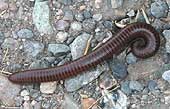Related Documents
Download Options
| Image Name | Width x Height | Size |
|---|---|---|
| SIA0365.jpg | 640 x 495 | 89K |
| SIA0365.jpg | 1200 x 928 | 282K |
| SIA0365.jpg | 2560 x 1980 | 913K |
Caption
Petroglyph National Monument is home to two resident species of millipedes, the Desert Millipede (Orthoporus ornatus) and the Slate Millipede (Comanchelus chihuanus). They are very easy to tell apart. The Desert Millipede is dark brown, averages 6 inches in length, and is the most common species seen. The Slate Millipede is dark gray, averages 3 inches in length and is considered rare. Despite their unusual appearance, they are quite harmless and extremely beneficial to the desert environment. Millipedes are nature's recyclers. They eat just about anything that is dead — plant or animal. This may sound kind of gross, but this turns out to be a very important part of the desert ecology. The desert environment is so dry that anything left out in the open tends to be preserved (this is one reason why there are so many ruins and archeological sites in the southwest). If the millipedes did not eat the dead plants and animals, they would take so long to decompose that the ground would be littered with them.
Even though the millipedes are harmless, they do have a defense mechanism. Whenever they are handled or bothered, they curl up into a spiral and ooze liquid through glands at the top of their legs. The liquid not only smells and tastes bad, but also is toxic to anything that might eat it. Millipedes are gentle creatures, but they should not be picked up. When you visit, please take the time to look at the millipedes while they go about their lives in the monument and see them for what they are beneficial, useful and interesting parts of our environment.
